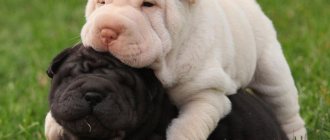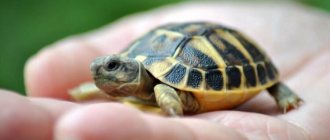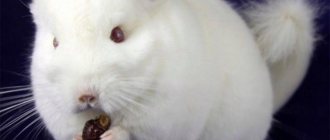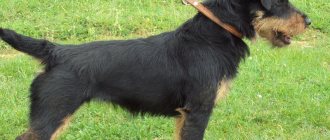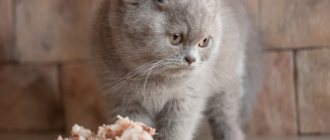The Russian Toy Terrier is a small, nimble, but timid dog.
It is distinguished by a small head with large, bulging eyes and large ears. Belongs to the decorative group.
There are two varieties of the breed - short-haired and long-haired.
We will talk about the long-haired variety in this article. You will learn about its characteristics, the specifics of care and nutrition, as well as how to choose the right purebred puppy.
Differences and similarities between the toy terrier and the Prague rat
Externally, these breeds are quite similar. But experienced dog breeders can easily distinguish them. But lovers and owners of pets of other species often confuse them.
The height of a ratlik (ratlik) is 18-23 cm, and a toy terrier is 28 cm. The first has large bones and weighs 2.6 kg. Toy – up to 3 kg.
The toy's ears are erect and set high, while the rat's ears are wide and at a slight angle to each other. The ratlik's muzzle is longer.
The top of the toy terrier gradually descends from the withers to the very tail; the rat dog has a straight back.
Accepted standard
The peculiarity of the breed is the compact size of the dog and thin bones. This is an elegant dog with long legs, whose weight does not exceed 3 kg, and the height at the withers barely reaches 28 cm.
Description of the breed standard :
- rounded head;
- prominent forehead;
- thin, triangular ears;
- weak cheekbones;
- a small nose, whose shade matches the color of the coat;
- square body format;
- Long neck;
- rounded loin and croup;
- legs are straight, with well-developed muscles;
- the hips are wide, but with weakly defined joints;
- the tail has a sickle shape, which is often docked;
- sexual characteristics are poorly expressed.
Expert opinion
Kozhevin Semyon Kirillovich
Expert dog handler.
A toy is a small pet with a small muzzle and large erect ears. This gives the impression that the pet is fragile, which is true, but only partly. In fact, the dog has well-developed muscles, and its body resembles a miniature Doberman. A distinctive feature of the long-haired Toy Terrier is the long locks and tassels that beautifully frame the ears. Smooth-haired toy terriers do not have this feature.
Characteristics of the Toy Terrier
Modern representatives of the Toy Terrier breed are small, long-legged dogs, curious, active, with an intelligent look. The animal is easy to train, but is not suitable for replacing service or hunting dogs.
The dog can be kept in an apartment and travel together.
The Toy Terrier's height is 20-28 cm, and its weight is 2-3 kg. The colors are black, blue, brown and tan, red, and has no spots, since this breed does not have a marble color.
The long-haired toy is distinguished by a small hairy coat (length - 3-5 cm), which requires daily care - combing.
By color
The official description of the breed initially mentioned one possible color - black and tan. Gradually the color palette expanded. Currently the color list includes 11 tones. Among them are different variations of tans:
- brown and tan;
- lilac and tan;
- blue-gray tan.
In cynology, tan is usually called the lighter-colored areas of fur that stand out against the general background and have a constant location. In Toychiks, tan marks are most often visible above the eyebrows and on the face, chest and paws.
The photo shows a smooth-haired Russian Toy with a lilac-tan color.
One of the most common colors is red, with the addition of black, brown, chocolate, cream, lilac and blue. In any combination, the color tonality should be rich. Snow-white color and white spots are considered a defect of the animal.
Character and appearance
The Russian Toy Terrier is a brave, cheerful and loyal dog. The animal is immensely affectionate, sociable, quickly becomes attached to the owner, and can be very upset by his loss. Despite this trait, the dog tends to be suspicious of strangers and warn of danger. This pet has good endurance, which allows it to move and travel together with the toy terrier.
Advantages and disadvantages
The breed has a number of advantages:
- pretty, not aggressive, friendly;
- easy to learn;
- tolerates travel and acclimatization well;
- small sizes do not affect security qualities;
- compact and undemanding in care;
- devoted.
Along with the advantages, there are also disadvantages:
- Often difficult pregnancy and childbirth in bitches.
- Zealous attitude towards the owner.
- Sometimes mentally unstable.
- Damage to objects and property.
All deficiencies can be eliminated with good care and proper upbringing.
Education and training
There are minimal requirements for such toy terriers, as they do not cause concern. And even if the puppy barks at passersby, such an offense may seem cute to them. But this is not the norm. Show dogs need to be taught to be touched by strangers and to react dispassionately to them. It is important for their psyche to have a calm attitude towards passers-by, neighbors, cars - the entire world around them. This is the basic point of socialization for almost any dog.
Don't know what to name your baby? Read the article: Choosing a nickname for a toy terrier boy and girl
The primary task is to instill in them the skills of maintaining personal hygiene and meeting their natural needs in the places designated by the owners. The same should be true with rest - the dog needs its own corner to sleep. It is important to immediately accustom the toy terrier to order in everything, to suppress the desire to spoil things and bite while playing. Read about what to do if your dog pees on the bed here.
See also: teaching a puppy to use the litter box (video)
The pet must respond, understand and fulfill basic requests. Training for almost all dogs is identical. The owners give commands to the toy terrier in a calm but confident voice, rewarding them for their execution. If you encounter difficulties in finding a common language with your pet, you should seek advice from a dog handler who knows the secrets of mutual understanding with animals.
Rules for caring for a long-haired toy terrier
Even such a miniature and decorative pet as a long-haired toy is still a dog and requires proper care, attention and education. It is impossible for a dog to grow on its own, so the owner must devote time not only to feeding and hygiene procedures, but also to training the baby.
You can start training your toy terrier as early as three months.
Upbringing
The first thing the owner of a toy terrier should know is that this little dog, no less than other, larger representatives of the canine world, needs education and a firm hand. No, this is not at all about hitting the toy - it’s absolutely not worth doing this. But when you get a puppy, you need to learn a few important rules from the first day:
- Explain to the dog what is allowed and what is not allowed - this applies to a place to sleep, eat, and play. The dog should sleep in a designated place, a warm and cozy bed should be equipped in the room where family members most often gather, but not on the aisle, not near the radiator or next to the window - the baby should be protected from drafts and overheating.
- The dog should have its own bowl for food and a second bowl for water. You should not allow your pet to beg at the table or take food to a secluded corner.
The dog should have two bowls
- The puppy needs to buy several toys that he will scratch his teeth on and with which he can have fun while no one is home.
- Teaching your dog to relieve himself in a diaper or in a litter box will help the baby not have to wait until he goes out for a walk if the owner is late at work.
- The dog must be accustomed to walking on a leash, and also respond to the command “Come to me” and its own name. First of all, this is necessary for the safety of the animal itself. There is no need to assume that a small dog is not dangerous to others, and therefore can walk on its own - a pet running without a leash can be hit by a car, bitten by a larger dog, or even taken by a passerby who thinks that the baby has no owner.
Let's learn the command "Come to me!"
Health
The owner of a toy terrier, especially a female dog, must understand that he bears great responsibility for a fragile creature. Why do we especially emphasize the importance of care for owners of female dogs? This is due to a common misconception - a dog must give birth at least once “for health.” This is fundamentally wrong, and for a miniature breed it can be fatal. Both pregnancy and childbirth are a lot of stress for a dog, and for a small toy terrier it is also a serious burden. There is no need to breed a dog just like that, without special knowledge and skills - due to its tiny size, the dog can die in childbirth.
Another health feature of long-haired Russian Toys is their tendency to alopecia or partial baldness. Most often, dogs lose their hair around the age of three; this is due to an unbalanced diet, poor care or heredity. To prevent your pet from losing its luxurious fur, it is necessary to undergo a veterinary examination at least once a year, since it is easier to prevent a disease than to treat it.
An annual visit to the veterinary clinic is beneficial for both the dog and the owner - for peace of mind
The last thing that can be said about maintaining the health of the Russian Toy is the importance of preventing injuries. A small dog can jump from furniture and break a leg, crawl under a sofa or closet, and die when it gets stuck. The dog may be accidentally stepped on, pinned by a door, or something heavy may be dropped on it. Therefore, it is not recommended to bring Toy Terriers into a family with small children who do not understand such responsibility. And the rest of the household must be extremely careful so as not to harm the baby.
Yes, a small dog is not a toy; it can cause a lot of trouble and take away a person’s time for affection, care and care. However, with the latter things are not so difficult.
Caring for a Toy Terrier's coat is not that difficult.
Treatments
Despite the fact that even the name of the breed contains the word “long-haired,” the Moscow Toy Terrier does not require special care. The dog needs to be brushed a couple of times a week, using a brush or a long-toothed comb, and the baby can be bathed when dirty or once every three to four months. To wash your dog, you need to use a special zoo shampoo with a gentle composition and a pH level suitable for the dog’s skin.
The rest of the procedures will be standard:
- Inspection and cleaning of the ears.
- Brushing your teeth with a special zoo paste.
- Trimming or filing nails.
- If necessary, eye care.
- Annual vaccination and quarterly administration of anthelmintic drugs .
Caring for teeth, ears and eyes is important for every dog.
Another item that is included in the grooming procedures is the selection of clothes for the toy terrier. Some owners buy a lot of clothes, including T-shirts, dresses and vests - for beauty. This is not necessary, but the dog really needs two or three sets for cold and wet weather. For autumn, a fleece jumpsuit that does not allow moisture to pass through is suitable; for snow and sub-zero temperatures - fur or padding polyester models.
Cool weather is a reason to keep your pet warm
To prevent your dog's paws from freezing and being exposed to road chemicals, you can teach him to wear boots. If you put shoes and clothes on your dog from an early age, then for the rest of his life he will feel calm and free on walks.
Video - How to wash a Russian Toy?
Diet, feeding
The long-haired toy terrier is a dog with sensitive digestion, and he is also prone to gaining excess weight, so the owner will have to carefully plan his feeding diet. The best option is to purchase dry ready-made food of the “holistic” class, intended for decorative small breeds. Such food is available in the brands “Go!”, “Akana”, “Nau”, “Eagle Pack”, “Barking Hands” and others. When choosing a dry diet, the owner only needs to follow the manufacturer’s recommendations regarding the daily dosage (indicated on each pack according to the dog’s weight), and provide the pet with constant access to clean, cool water.
In holistic food, the meat component reaches 80%
If the owner wants to feed the dog natural products, he must forget about soups, cereals, and food from the human table. The basis of the diet should be fresh raw meat, fish and poultry. The menu also includes offal, vegetables and fruits, herbs, eggs, lactic acid products (low-fat yogurt, kefir).
A balanced diet keeps your pet healthy
Fruits and vegetables such as carrots, zucchini, apples, pumpkin, asparagus are a source of micro- and trace elements, as well as vitamins. They are given raw, finely chopped or grated. To make these products digest better, add a drop of vegetable oil, such as olive oil.
The following foods are permanently excluded from the toy terrier’s diet:
- Whole milk.
- Smoked, salted, fried dishes.
- Cheese, sour cream, butter.
- Any sweets, flour, baked goods.
Instead of sweets, dogs include fruit in their diet.
In any situation, no matter what type of feeding (“dry” or “natural”) the owner of the toy terrier chooses, it is prohibited to suddenly change the puppy’s diet. For the first month after purchasing a dog, you need to feed it exactly as the breeder did. This is necessary so that the baby does not get even more stressed. You need to gradually transition your dog to unfamiliar foods, gradually introducing new ingredients into the diet.
One of our articles provides options for natural diets and ready-made dry industrial food suitable for this particular mini-breed.
Breeding
This breed has few litters. Large fetuses complicate childbirth and make it painful. With a weight of 1.5 kg, the female is at risk for her life, and with less than 2 kg it is better to wait a little.
It is also worth familiarizing yourself with which puppies were born from the male that was used for mating. Often a small boy is selected so that the offspring of the toy terrier will also be miniature, and delivery will be easier. It is also impossible to breed a dog too early, since its body is growing until it is 15 months old.
Breeding is a big responsibility. The girl may have toxicosis, she may completely refuse to eat and then she will need the help of a veterinarian who will give appropriate recommendations.
Care and maintenance
Taking care of the Moscow Toy Terrier is not difficult at all.
- Ears are checked monthly and cleaned with a cotton pad.
- They monitor the loss of baby fangs, which can cause the formation of malocclusion in the toy terrier. Brush your dog's teeth regularly.
- Toys are bathed once every six months. More frequent water procedures are undesirable due to his dry and sensitive skin.
- Brush the dog daily.
- Puppies have their nails trimmed every 15 days, and adults – once a month. During seasons of walking on hard surfaces, the toy terrier’s claws wear down on their own.
- The young animal is walked 4 times a day. With an adult dog they go outside in the morning and evening.
History of the origin of the breed
The Longhaired Toy Terrier is a young breed with ancient roots. She is a little over sixty years old, but the first terriers, her ancestors, were used in Europe already in the Middle Ages.
Terriers are born English
English terriers were burrowing hunting dogs, catching medium and small animals: foxes, badgers, otters, raccoons. Manchester black and fawn terriers were especially loved for their agility and tirelessness in exterminating rats and other synanthropic rodents that carried diseases dangerous to humans.
Some time later, from the large terrier family, a group began to separate out, distinguished by its small size - the small Manchester terriers. For a long time (in some countries still) they were considered just a variety, and not a separate breed. This only changed in 1962. At the same time, due to their dwarf stature, the prefix “toy-” was added to their name, which means “toy”. At the beginning of the 19th century, they quickly spread as decorative lap dogs far beyond England.
Toy Terriers with Russian Features
In Russia, toy terriers were bred mainly among the rich, prosperous sections of the population. That is why the October Revolution caused enormous damage to the breed. When small dogs were declared useless for the national economy and the Soviet Army, the Russian toy population declined critically and was preserved only thanks to enthusiasts.
In the fifties, dog handlers began to recreate the breed, but they had to work with non-purebred animals; The Iron Curtain prevented the “cleansing” of genetics. Our own breed standard was developed, the exterior of which differed from that of English terriers. For example, “Russian” terriers had a sharp transition from forehead to muzzle.
Long-haired toy - origin
The ancestor of modern long-haired toys - the first dog with beautiful feathering on the ears and paws and long hair on the chest - was born in Moscow in 1957. It was a male Chikki. His unusual appearance attracted the attention of both ordinary people and professionals. Evgenia Zharova and Moscow dog handlers working at the Moscow City Society of Ornamental Dog Breeding decided to “fix” the animal’s genes, carried out selection activities and as a result received a new breed - the Moscow Toy Terrier. Over the course of several decades, its development has experienced both ups and downs. Our “longhaired” breed standard has yet to be recognized by the Fédération Cynologique Internationale.
Feeding
It is better to decide in advance whether your pet will have a diet of natural products or specialized food. Veterinarians do not approve of mixed feeding for this breed. Do not be afraid of monotony when using ready-made food - these dogs tolerate it well.
The amount of food consumed by a toy terrier directly depends on the dog’s age and size. The information on the packaging will help you determine the norm.
When choosing food ingredients, take into account that neither the puppy nor the adult dog is fed the same dishes that the family eats. The animal needs an individual, balanced menu. Calculation of portions will be about 80 g per 1 kg of dog weight. Forbidden for a toy terrier are pasta, egg whites, sausages, smoked foods, sweets and sugar, fatty dairy products, everything hot and spicy.
A one and a half month old puppy has 6 meals a day, and they switch to 5 meals a day from 2 months; from 5 months the dog is gradually transferred to 4 meals a day. From 7, an animal needs three doses, and from 9 – 2 times a day.
Expert opinion
Anna Abramenko
An avid dog lover. Experience in veterinary medicine since 2009.
Ask a Question
Fish, lean meat, kefir, and vegetables are very useful for the toy terrier.
Hygiene procedures necessary for this breed
Remember to examine your animal's eyes daily. If discharge is found in the corners, they must be removed with a cotton pad soaked in warm water.
Check your toy's ears every 4 weeks. Sulfur deposits should not accumulate there. Unpleasant odor is also prohibited. Clean only the visible parts of the ears; do not penetrate deep into the ear. Clean them with a cotton swab and never use your finger.
Once every 4 weeks, inspect your dog’s nails - if they are long, they need to be shortened. Because otherwise they may break off or dig into soft tissue.
Close attention should be paid to the animal's anal glands. If suddenly they are filled with an odorous secretion, then the dog gets nervous and rubs his butt against the carpet. In this case, they must be released. You can do this yourself - gently press your thumb and index fingers on the bottom and sides of the anus.
Health and treatment
Unfortunately, there are common diseases for this breed, many of which develop at the genetic level. The musculoskeletal system of miniature terriers is at risk for these reasons and due to increased activity. The dog needs attention to prevent injury.
Eye diseases, which include conjunctivitis and senile cataracts, also have a genetic predisposition.
Dogs of this breed often lose teeth early due to periodontal disease and tartar. Therefore, you need to monitor your toy terrier’s diet, brush it promptly, and remove plaque from the teeth.
Expert opinion
Anna Abramenko
An avid dog lover. Experience in veterinary medicine since 2009.
Ask a Question
It is worth asking about the presence of allergic reactions in the pet's parents; it is also often inherited.
Many neuralgic diseases appear in puppies and require surgical intervention.
Due to its fragile build, the dog does not tolerate weather changes well - heat, cold, rain. Therefore, your pet should be protected from hypothermia and overheating.
Symptoms of diseases in dogs of this breed:
- lethargy;
- refusal of food;
- temperature;
- the appearance of discharge from the eyes or nose.
Expert opinion
Anna Abramenko
An avid dog lover. Experience in veterinary medicine since 2009.
Ask a Question
You should not self-medicate your toy terrier or give medications at random, but it is better to show the animal to a veterinarian in a timely manner.
What not to do with a dog
It is worth remembering about safety measures for your pet. This dog should not be placed in bed with you, or placed on a chair or armchair, to avoid injury.
Toys for animals should be made of hard rubber. Rags should not be given to the puppy, due to the risk of swallowing some of them. If you see that your baby is playing with something soft, take it away, but do not pull (this can break the animal’s bite), but slightly unclench the jaws.
You need to pick up the puppy correctly - your left hand under the chest, your right hand holding it. It looks like a puppy is sitting on your right hand. Holding a puppy differently is not recommended. And when you go somewhere in the evening, leave your pet a light and plenty of toys so that he doesn’t worry. You can throw a few bones for the teeth of the baby. Then he will know exactly what to do with himself.
Lifespan
Representatives of this breed live 10-15 years, but some individuals have delighted their owners for 25 years. It all depends on the state of health, care and nutrition. Vaccination of the dog is mandatory.
Mini Toy Terriers are less likely than other relatives to be in good health. Their lifespan is 3-5 years. This is explained by the fragile health of all dwarf animals.
Expert opinion
Anna Abramenko
An avid dog lover. Experience in veterinary medicine since 2009.
Ask a Question
Wearing of teeth is an indicator of old age in pets, but for toys the situation is somewhat different, since this is a feature of the breed.
Advantages and disadvantages
This dog is very sociable. The Toy Terrier easily puts up with the rhythm of life of its owner and adheres to it.
The dog's disadvantages include some health problems, including genetic predisposition. The disadvantages include the presence of an explosive temperament and willfulness.
Expert opinion
Anna Abramenko
An avid dog lover. Experience in veterinary medicine since 2009.
Ask a Question
The pet should be raised from puppyhood, disciplined, and mutual understanding achieved. A pampered animal will get used to permissiveness, begin to demand the desired goodies, sleep on the bed and fully demonstrate the negative sides of its character.
Rules for choosing a puppy
Parameters by which a purebred toy terrier is selected:
- The weight of a three-month-old individual is at least 1-1.5 kg.
- The bite is scissor-shaped, and there should be 6 teeth between the canines on each jaw.
- A show pet is purchased at the age of 4 months.
- White spots on a Toy Terrier's body are not disqualifying, but are undesirable. Marble - tribal marriage. Long-haired puppies are characterized by feathering on their paws and ears.
- If your pet is inactive or shy, this may indicate a disease. It is better to repeat the visit and observe a second time, since activity and curiosity are inherent in this breed from an early age.
- Rash, bald spots, discharge, hot ears are bad signs for a toy terrier. There is no dandruff or redness in healthy pets.
- Particular attention should be paid to the gait and limbs of the terrier. Lameness is unacceptable.
- A puppy's timidity or angry mood is not a reason to refuse. Representatives of this breed love their owners, are cautious with strangers, and the potential buyer is not yet the owner. It is better to try to establish contact with the puppy and offer a treat.
How to choose your future pet?
Kennels sell puppies 40-45 days old. At this age, dogs have already erupted their milk teeth and the pets are ready to move.
Before purchasing, the animal is examined for skin diseases, inflammation, and rashes. When choosing a pet, it is advised to pay attention to the paws (without curvature) and the tummy (should not be large and inflated). Puppies are characterized by cheerfulness and activity, so look for a puppy with shiny eyes and fur.
There is reason to be wary if:
- the puppy is not allowed out of the crate during examination;
- there are signs of strabismus;
- the pet has bulging eyes;
- no passport;
- discharge from the nose, eyes.
Puppy cost
The price of toy terrier puppies depends on the pedigree. Bitches are usually more expensive. Long-haired ones are also slightly more expensive than smooth-haired pets. In general, prices range from $200 to $700.
You should choose a puppy of this breed from nurseries or breeders. It would be a great idea to visit exhibitions and dog breeding clubs. It is necessary to choose a toy terrier with a stud book and get to know its relatives. This is required to be confident in the pet’s genetic predispositions.
Expert opinion
Anna Abramenko
An avid dog lover. Experience in veterinary medicine since 2009.
Ask a Question
There is no point in looking for high-breed puppies on message boards. Professional nurseries have personal resources. If the publication is posted by breeders, then it should contain detailed information about breeds and nicknames.
A responsible owner does not sell unvaccinated toy terrier puppies until quarantine (2.5 months).
Reviews
Olga: “The dog is a real little friend, always bringing positive emotions with his activity and enthusiasm. But a pet does not impose society; the toy terrier has the patience to wait until the owners are free for joint leisure.”
Nikolay: “It is important to start raising a toy terrier in a timely manner. If you miss the right moment, he can easily become the master of the situation and show waywardness. Retraining a dog is much more difficult. This also applies to barking for no reason.”
Nikita: “We are very pleased with the purchase of this particular breed. The dog gets along well with children and goes for walks with them. Caring for a baby is not difficult, you just need to give your toy terrier time, care and love.”
Summarizing
The Longhaired Toy Terrier is a charming little dog with a doll-like appearance, but a big and brave heart. Such a pet should be owned by a sensitive and gentle person who understands how important walks, training and a caring attitude are for a dog.
If the owner can properly socialize the toy terrier, give him enough opportunities to show his high intelligence, and devote a lot of time and effort to him, then he will receive a faithful friend and companion for any activity, be it a long journey, an interesting walk, or just watching TV on sofa
Active walks mean a healthy dog!
Photo and video review
Graceful toy terriers often take part in exhibitions. A miniature companion and reliable friend. An active and kind dog with a charming look.
